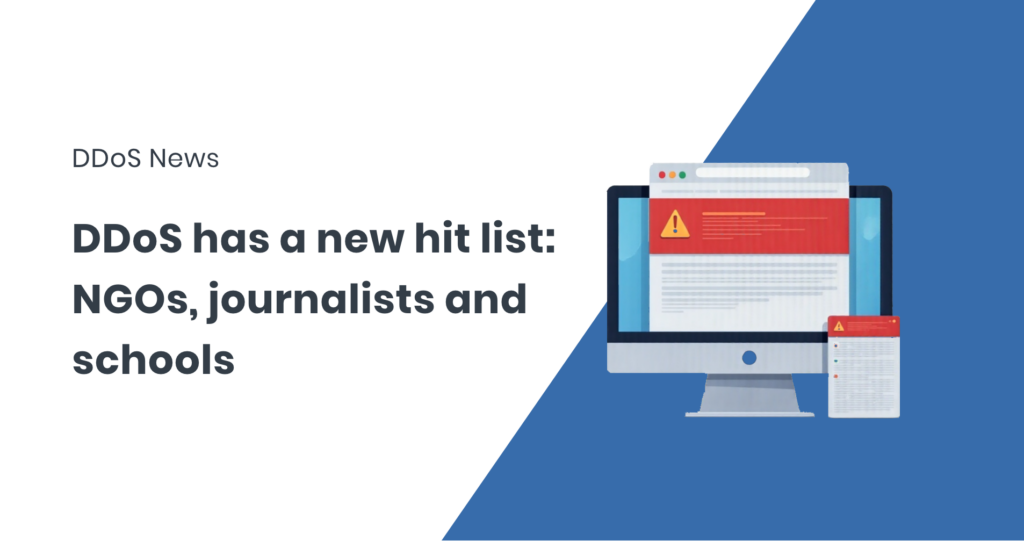Historically, DDoS attacks focused on obvious targets: banks, telecoms, gaming platforms, and government services. But in 2025, the landscape has shifted. Today’s DDoS campaigns are increasingly aimed at organisations that weren’t considered strategic targets just a few years ago.
Nonprofits, universities, and independent media outlets are now regularly under fire. These attacks aren’t always large or long-lasting — but they’re timed for disruption and designed to silence.
Let’s look at who’s in the crosshairs and why.
1. Civil Society & Nonprofits: Disruption as a Political Tool
Human rights groups, nonprofits, and advocacy organisations are experiencing a sharp uptick in DDoS activity — especially around elections, protests, or the release of sensitive investigations.
These aren’t random. They’re deliberate attempts to knock platforms offline during high-stakes moments.
Civil society groups often operate with limited resources, lean infrastructure, and minimal security hardening. This makes them ideal targets for volumetric floods or burst attacks that overwhelm basic hosting.
- Cloudflare reported a 241% year-over-year increase in blocked DDoS traffic targeting independent media and civil society organisations.
- The CyberPeace Institute and other watchdogs have linked these campaigns to broader attempts at censorship and digital repression.
2. Education: Infrastructure That Wasn’t Built for This
Education moved online fast — and security has not always kept up with the digitalisation.
Student portals, grading systems, and remote learning tools are now core infrastructure for schools and universities worldwide. DDoS attacks in this sector tend to spike during:
- Exam periods
- Registration deadlines
- Major political events (when targeting research-active institutions)
Whether it’s activism-related or opportunistic, education networks are increasingly being hit — not for money, but to disrupt.
3. Independent Media: Shut Down the Story Before It Spreads
Smaller media outlets and independent journalists are facing a growing wave of targeted DDoS attacks — especially when publishing sensitive or politically charged stories.
These attacks are cheap to launch and devastating when timed right. Many small outlets run on basic setups: a CMS, a CDN, and minimal backend capacity. A few minutes of well-timed downtime can kill visibility and momentum.
The recent 6.3 Tbps attack against KrebsOnSecurity demonstrates that attackers now have access to staggering amounts of traffic — often far more than is needed to disable a target. In that case, the site remained online, but the message was clear: attackers are willing to unleash massive force, even against relatively small, independent voices.
Why Is This Happening Now?
Yes, DDoS is easier and cheaper to launch than ever.
- Botnets are rentable
- Toolkits are plug-and-play
- IoT vulnerabilities continue to provide firepower for attackers
We broke this down in detail in our blog post: DDoS Booters and IP Stressers: Explained by Experts
But the deeper shift is geopolitical. We’re seeing DDoS used more frequently as a low-cost, high-impact tool for censorship and destabilisation — a way to disrupt services without attribution and to apply pressure without a physical presence.
For more, read: DDoS in Geopolitics: When Network Traffic Becomes a Digital Weapon
What Can Organisations Do?
No one is immune from being targeted, but there are ways to prepare and respond:
Map Your Exposure
Identify your public-facing infrastructure, assess vulnerabilities, and understand what’s likely to break under load.
Avoid Single Points of Failure
Use caching, redundant DNS, and geographically distributed infrastructure to avoid total service outages.
Use the Right Protection Tools
For civil society, nonprofits, and smaller networks, FastNetMon Community Edition offers free, high-quality DDoS detection and basic mitigation. It’s used globally by universities, internet exchanges, and research organisations.
For larger-scale or more complex environments, FastNetMon Advanced Edition adds automation, flow protocol support (NetFlow, IPFIX, sFlow), and deeper visibility into traffic anomalies. You can compare Community and Advanced editions here.
About FastNetMon
FastNetMon is a leading solution for network security, offering advanced DDoS detection and mitigation. With real-time analytics and rapid response capabilities, FastNetMon helps organisations protect their infrastructure from evolving cyber threats.
For more information, visit https://fastnetmon.com

